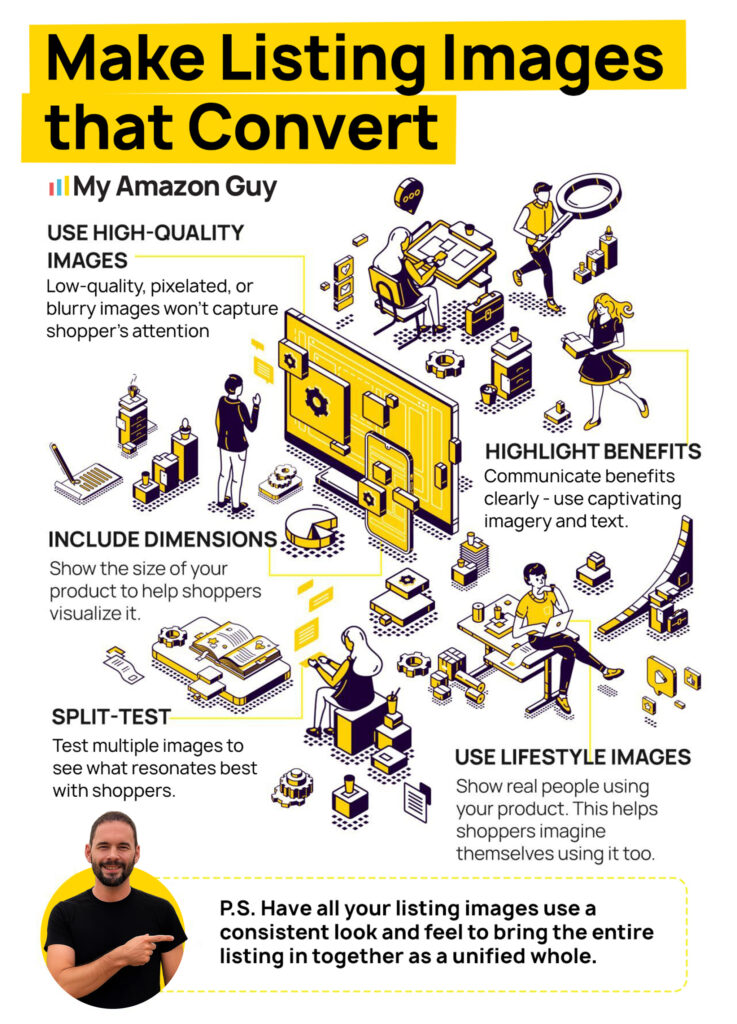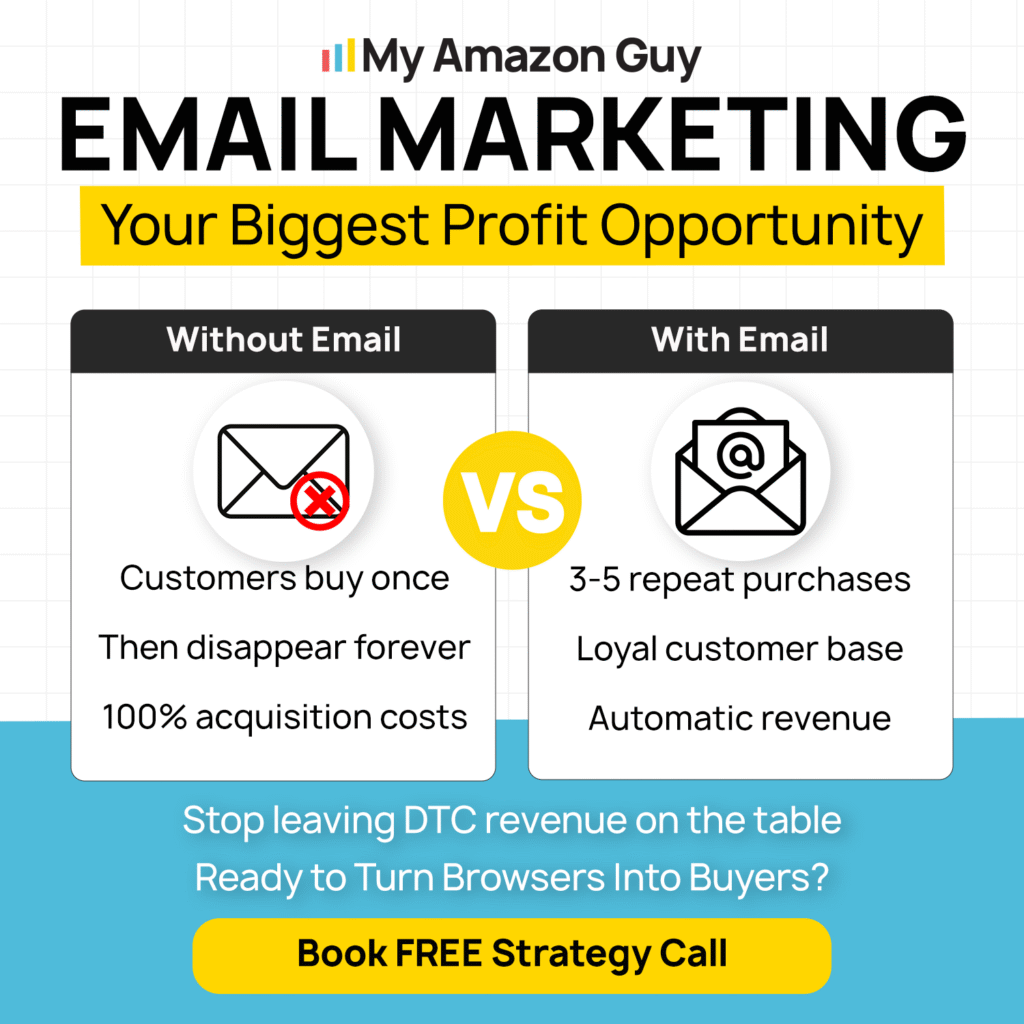
Can’t get customers to come back and buy your products again? You might want to try an e-commerce subscription business model, which is a proven way to turn one-time buyers into repeat customers and build predictable revenue every month.
When it comes to e-commerce, most sellers celebrate every new customer. But relying only on new buyers makes growth unstable because repeat customers are what truly sustain long-term success.
That’s where subscription models come in. They create automatic repeat orders, boost customer loyalty, and help brands build consistent cash flow without constantly chasing new sales.
This article breaks down how an e-commerce subscription business model works, including its benefits, challenges, and steps to set it up successfully. Our Amazon agency also explains how sellers can optimize their subscription strategy to drive repeat purchases, boost loyalty, and build consistent revenue.
Table of Contents
Build Predictable Profit Every Month
We’ll help you implement a subscription model that fits your brand and maximizes retention.
What is an E-commerce Subscription Business Model?
The e-commerce subscription business model is a setup where customers pay a recurring fee to receive products or access services on a regular schedule. It could mean monthly deliveries of essentials, curated product boxes, or exclusive membership perks that keep customers engaged and spending.
E-commerce sellers use this model because it focuses on customer retention rather than one-time sales. Studies show that repeat customers spend up to 67% more than new customers, proving how valuable loyalty and consistent purchasing can be for long-term growth.
Types of E-commerce Subscription Business Model
There are different types of subscription models that sellers can use when they choose to implement an e-commerce subscription business model. Each one offers unique advantages and suits specific product types or customer needs.
1. Replenishment Subscription Model
The replenishment model focuses on convenience; it lets customers automatically reorder the products they use regularly, often at a discounted rate. It’s ideal for consumable items like razors, pet food, supplements, or skincare products.
This model works best for sellers who want predictable sales and strong retention rates. Customers love the ease of not having to reorder manually, which means brands benefit from steady, recurring revenue month after month.
2. Curation Subscription Model
The curation model revolves around delivering personalized or themed boxes that surprise customers with new products or experiences. It’s popular in industries like beauty, apparel, and food, where customers enjoy discovering something fresh and exciting each month.
This model helps brands build emotional connections and long-term loyalty through personalization and variety. However, maintaining engagement requires constant creativity, as customer interest can drop if the surprise element fades over time.
3. Access Subscription Model
The access model gives customers exclusive perks, such as early product releases, discounted prices, or member-only content, in exchange for a recurring fee. Examples include Amazon Prime and JustFab, where the main value lies in exclusivity and added benefits.
This model helps brands build a strong community and customer retention. While it encourages repeat engagement, sellers must consistently deliver value to keep members subscribed and satisfied.
Pros and Cons of Using an E-commerce Subscription Business Model
Like any other strategy, the e-commerce subscription business model comes with its own set of benefits and drawbacks. Understanding both can help you decide whether this approach aligns with your products, goals, and overall business strategy.
Benefits of Using an E-commerce Subscription Business Model
There are several reasons why sellers choose to adopt an e-commerce subscription business model. It’s an effective approach that thrives on customer retention and convenience, especially since more than 54% of online shoppers have subscribed to at least one e-commerce subscription box service.
But beyond popularity, this model offers a range of powerful business advantages:
- Recurring payments provide a steady income and a predictable cash flow.
- Lower marketing costs since customers return automatically.
- Subscribers stay longer and spend more over time.
- Repeat orders strengthen loyalty and reduce churn.
- Predictable demand simplifies inventory management.
- Consistent revenue makes budgeting and planning easier.
- Exclusive perks and offers boost customer satisfaction.
- Ongoing relationships enable cross-selling and upselling.
- Subscription data reveals useful customer insights.
- Automated billing and delivery improve convenience.
Drawbacks of Using an E-commerce Subscription Business Model
Just like any business model, although this one offers many benefits, it also has its drawbacks. Learning about these disadvantages helps you decide if they’re worth the trade-off and prepares you for what to expect once you encounter them.
Below are the most common challenges of a subscription business model:
- High customer acquisition costs make it expensive to attract new subscribers.
- Customers may cancel if they feel the subscription no longer offers value.
- Subscription fatigue can set in, leading to higher churn over time.
- Some customers hesitate to commit to recurring payments.
- Managing recurring billing and logistics requires strong systems.
- Scaling operations quickly can strain fulfillment and support.
- Inventory forecasting becomes more complex as demand fluctuates.
- Intense competition makes it hard to stand out and retain subscribers.
- You must constantly add value to justify ongoing costs.
- Regulatory and data compliance add extra administrative pressure.
Ready to Scale Smarter, Not Harder?
Stop chasing one-time buyers. Let our team help you create a steady stream of loyal subscribers.
How to Implement a Subscription Business Model
Knowing the benefits and drawbacks of using an e-commerce subscription business model, some sellers may choose to implement it. However, many don’t know how to set it up correctly, so we’ve created this guide to help you implement it with ease.
1. Choose a Subscription Model
The first step in implementing a subscription model is selecting the right type for your business. You can choose from Curation, Replenishment, or Access models, each serving different customer needs and preferences.
The Curation model involves assembling a set of products for regular delivery, while Replenishment focuses on products customers need frequently, such as toiletries or pet food. The Access model offers memberships for exclusive deals, early product releases, or access to gated content, which is ideal for brands offering unique value.
2. Curate Your Products
Once you’ve selected the model, the next step is curating the products you’ll offer through your subscription service. Look at your existing products and analyze sales data to find the most popular and appropriate items for your subscription.
Curating products can help reduce overwhelm for customers and increase satisfaction by offering them what they need or enjoy. Whether you’re bundling products in a box or creating personalized selections, curation adds a touch of exclusivity that keeps subscribers engaged.
3. Create a Pricing Model
Pricing your subscription offering correctly is essential to your business’s success. You want to strike a balance between profitability and value, so ensure your pricing aligns with customer expectations and your costs.
Research what competitors charge for similar services and tailor your pricing based on market demand. Testing your pricing strategy and adjusting as needed will help optimize conversion rates and customer satisfaction.
4. Develop Effective and Consistent Branding
Effective branding helps build recognition and trust with both existing and potential subscribers. Make sure your brand message, visuals, and tone are consistent across all channels, including your website, packaging, and marketing campaigns.
Strong branding creates a clear identity that attracts subscribers and strengthens customer loyalty. Use your brand’s unique personality to stand out in a crowded market and make your offering memorable.
5. Leverage Photography
Good photography can make or break a subscription business, so invest in high-quality images that highlight your products effectively. Whether it’s showcasing a box of curated items or highlighting individual products, visuals should entice customers to subscribe.
High-quality photos displayed across your website, social media, and online ads can boost conversions. Providing clear and visually appealing images will help potential subscribers better understand the value they’ll receive.
Optimizing Your E-commerce Subscription Business Model
To get the most out of your subscription business model, optimizing your strategy is a must to drive sustainable growth and keep customers engaged. While there’s no one-size-fits-all formula, several proven tactics can help sellers strengthen retention, boost revenue, and maintain customer satisfaction.
1. Offer Flexible Subscription Options
Flexibility keeps customers from feeling locked in. Allowing subscribers to pause, skip, or switch products gives them control over their experience and reduces the risk of cancellations.
Tiered pricing and customizable plans make your service appealing to more people. When customers can adjust their subscription to fit their needs, they’re far more likely to stay long-term.
2. Strengthen Customer Retention and Support
Excellent customer service is the backbone of any subscription model. Subscribers expect quick responses and consistent support across all channels.
Focus on smooth onboarding, proactive communication, and follow-ups that show genuine care. When customers feel supported, they remain loyal, and repeat purchases directly translate to lower churn and higher lifetime value.
3. Leverage Data and Analytics
Subscription data is a goldmine for understanding customer behavior. Analyzing purchase frequency, churn triggers, and engagement patterns helps you make smarter business decisions.
Use these insights to personalize offers, improve renewal timing, and fine-tune your marketing strategy. Data-driven optimization ensures your brand evolves with your customers’ needs and keeps them subscribed longer.
4. Refine and Reinforce Your Value Proposition
Customers must consistently see the value in what they’re paying for. Regularly revisit your product offerings, pricing, and messaging to make sure they align with what your audience truly values.
Highlight your unique benefits, whether it’s convenience, personalization, or exclusive perks. A clear, evolving value proposition keeps your brand relevant and your subscribers satisfied.
5. Build a Strong Brand Community
A loyal community is one of the most powerful assets in a subscription business. When customers connect with your brand values and feel part of a group, they’re less likely to leave.
Engage with subscribers through social media, email, and exclusive groups that promote conversation and connection. This sense of belonging transforms customers into advocates who naturally promote your brand.
Frequently Asked Questions
Is a subscription-based business model suitable for all types of e-commerce products?
Not always. It works best for products people buy repeatedly, like beauty, health, food, or pet supplies, but less so for one-time or long-lasting items.
How can I reduce customer churn in my subscription business?
Focus on delivering consistent value, offering flexible plan options, and maintaining strong customer communication. Regularly check in with customers to understand why they cancel and fix the pain points fast.
What’s the hardest part of running an e-commerce subscription model?
Managing retention and forecasting inventory are the biggest challenges. It takes the right systems, data tracking, and customer engagement strategy to keep the model profitable long-term.
Is a Subscription Model What Your Store Needs?
There are many business models that work for e-commerce sellers depending on their goals, resources, and products. One that often gets overlooked is the subscription-based business model, which can drive steady income and stronger customer loyalty when done right.
Unfortunately, many sellers skip it because they think it’s complicated or only suited for big brands. In reality, any seller offering products with repeat demand can build predictable revenue through well-managed subscriptions.
Having a hard time making your e-commerce site run on a subscription-based business model? Contact our full-service Amazon agency, and let our e-commerce experts set up, manage, and optimize your subscription program for consistent, scalable growth.
Simplify Your Growth Strategy
A subscription-based approach could be your next big win. Our e-commerce experts know exactly how to set it up right.








